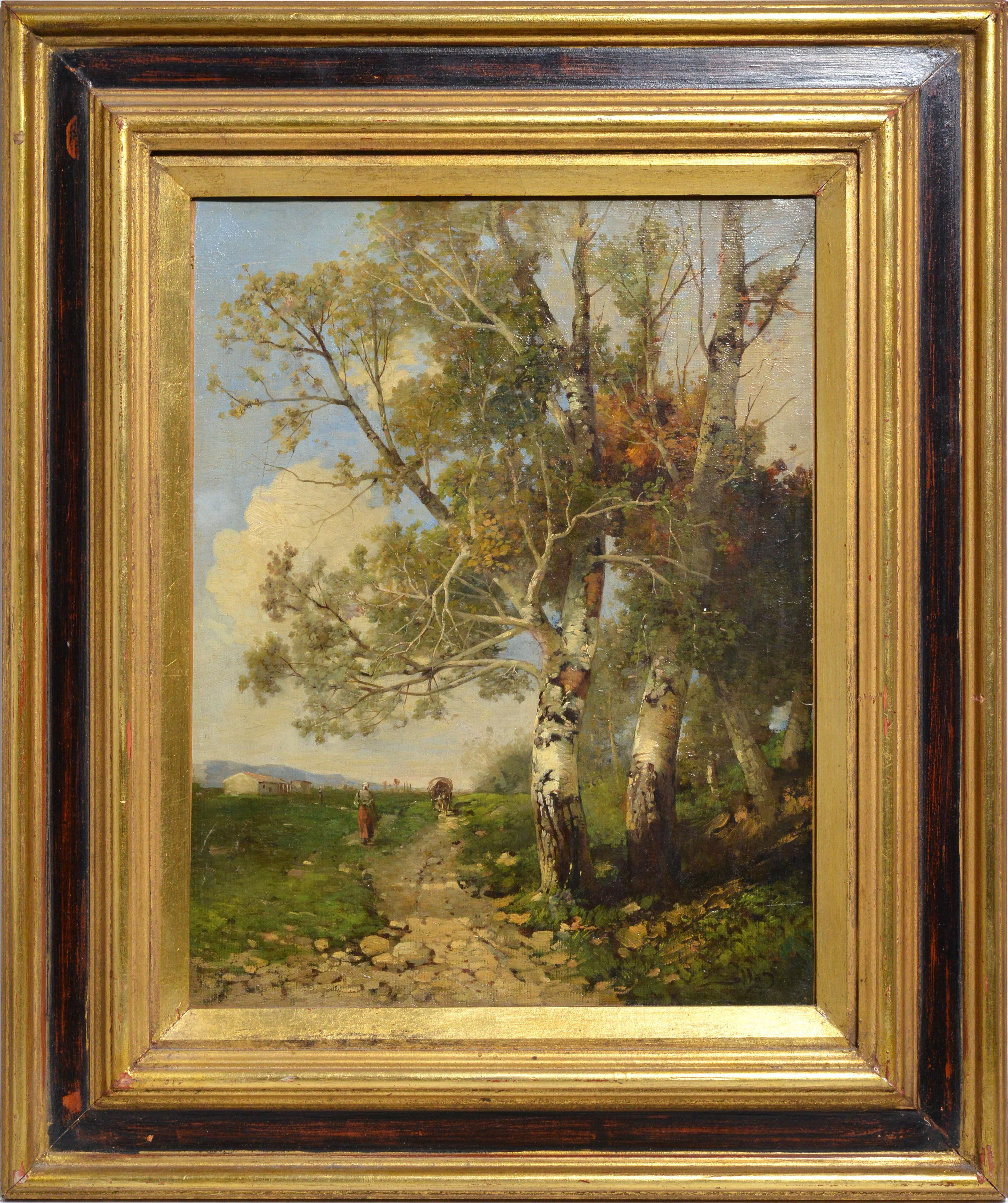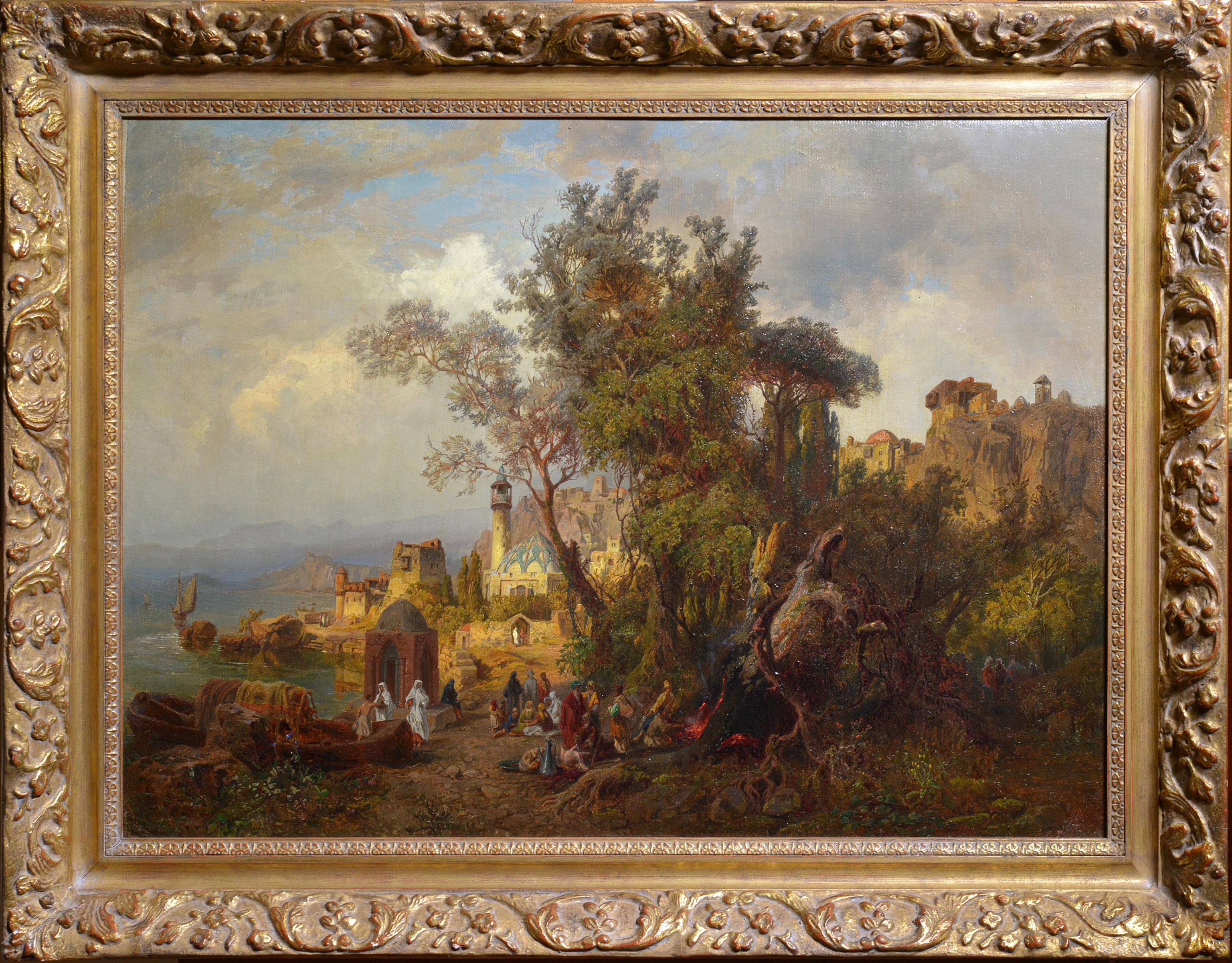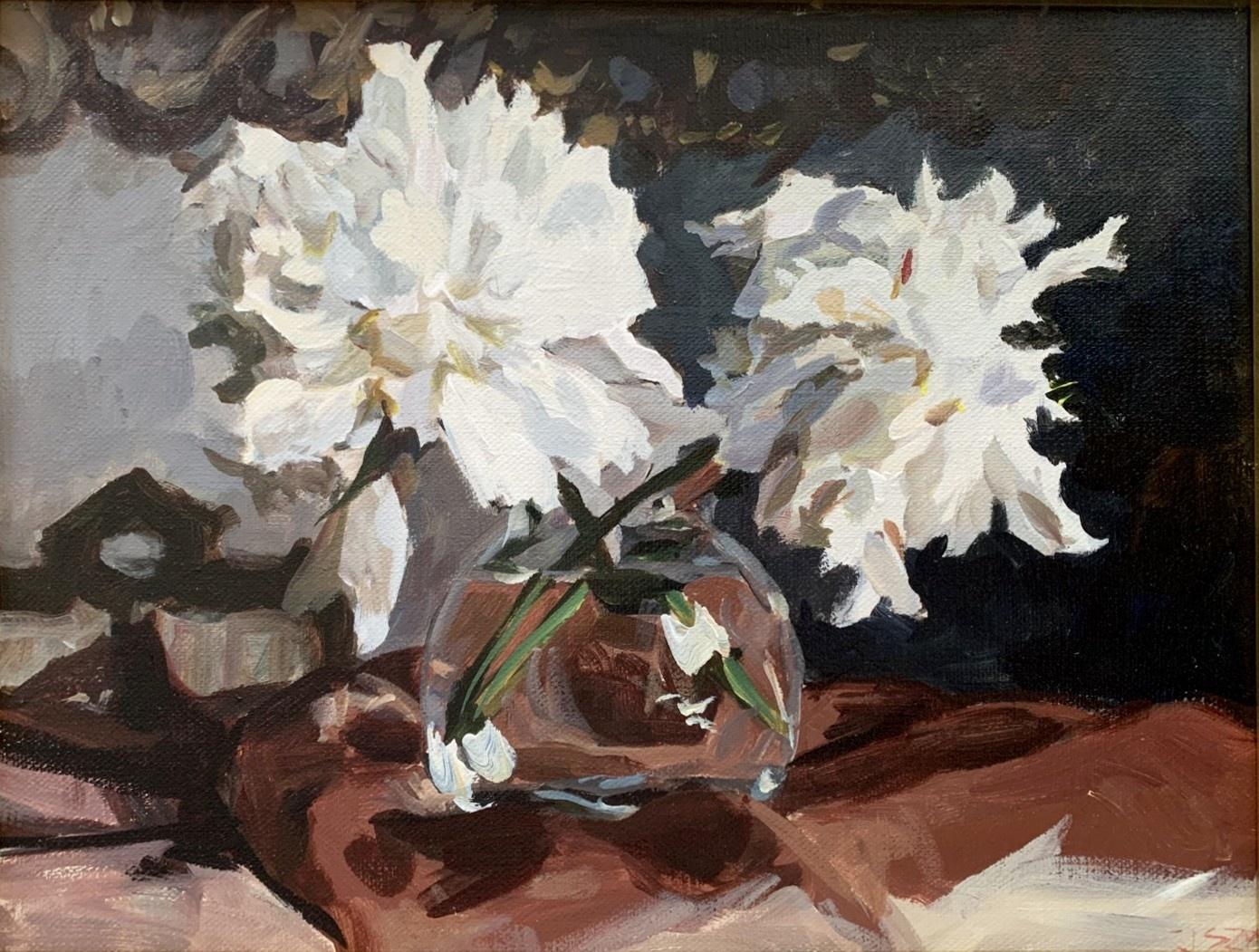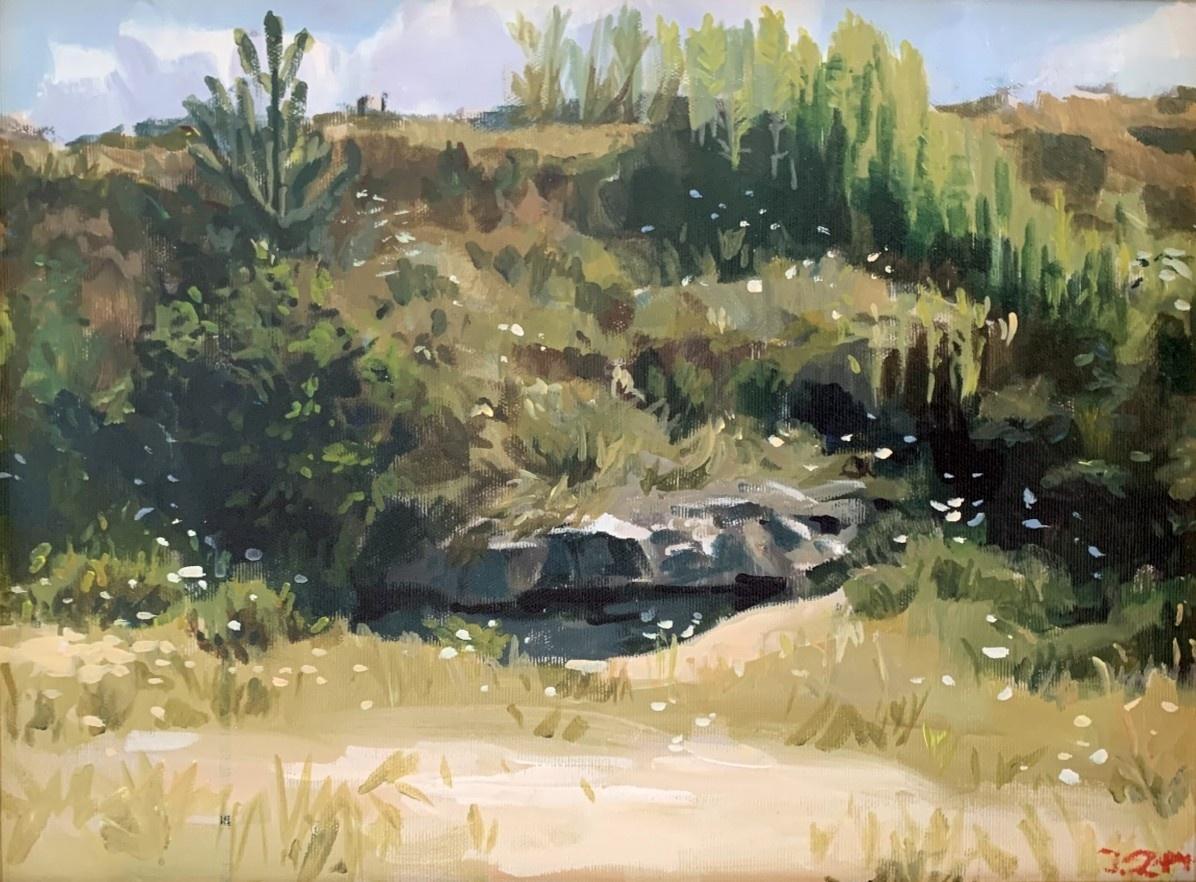Items Similar to "Before the Walls of Jerusalem", 19th Century Oil on Canvas by José Villegas
Want more images or videos?
Request additional images or videos from the seller
1 of 12
José Villegas"Before the Walls of Jerusalem", 19th Century Oil on Canvas by José VillegasCirca 1880
Circa 1880
About the Item
JOSÉ VILLEGAS CORDERO
Spanish, 1844 - 1921
BEFORE THE WALLS OF JERUSALEM
signed "Villegas" (lower left)
oil on canvas
12-1/4 x 17-1/4 inches (31.1 x 43.7 cm.)
PROVENANCE
Private Collector, Seville, Spain
José Villegas Cordero (Seville, August 26, 1844-Madrid, November 9, 1921) was a Spanish painter. He directed the Prado Museum between 1901 and 1918.
He was the brother of the painter Ricardo Villegas Cordero. He began his apprenticeship very young with José María Romero, with whom he remained for two years until entering the School of Fine Arts in Seville, where he was under the tutelage of Eduardo Cano.
In 1860, when he was only 16 years old, he sold his work Little Philosophy for 2,000 reais at the Seville Exhibition. In 1867 he traveled to Madrid, where he entered Federico Madrazo's studio. There he established friendship with painters Eduardo Rosales and Fortuny.
He went regularly to the Prado where he copied Velázquez, from whom he acquired spontaneity and the use of color for his technique.
Finally, and out of admiration for Fortuny's orientalist painting, he returned to Seville and organized an excursion to Morocco.
At the end of 1868 he decided to travel to Rome accompanied by the painters Rafael Peralta and Luis Jiménez Aranda, where he ended up entering Rosales' workshop.
His first works in the Eternal City have a costumbrista tint, which is also a highly demanded theme by the public. Proof of this are his works Improvised Toilet, Bullfighters in the Plaza Chapel (1871) and The Rest of the Gang (1873), among others.
Orientalist themes were also demanded of him, which Villegas was able to masterfully carry out thanks to the sketches he had treasured in Morocco, as well as certain works of "genre painting". In the mid-1970s he returned to Seville and took the opportunity to visit Morocco again.
Again in Rome, he picked up the witness from Fortuny and thus became the best-regarded and most sought-after painter in the city. In these times, the paintings of costumbrista and also orientalist themes exploited. Some of his works could be seen in Seville thanks to regional exhibitions and in Madrid thanks to the Bosch and Hernández galleries.
In 1878, the Senate commissioned him a canvas with a historical theme that should be about Hernán Cortés's interview with Moctezuma. In 1882 the Senate withdrew the commission, but Villegas had already been interested in historical painting and embarked on works such as La paz de Cambray and Don Juan de Austria's last visit to Felipe II, all of them of excellent workmanship.
From 1877 on, he frequently resided in Venice, where he fed on his views to set pictures such as The Feast of Marys and The Redeemer's Procession. It also exploited at this time themes inspired by the Italian Renaissance, such as Venetian Lady of the 16th century, Doge Moncenigo and Palace of the Venetian Republic among others. Many of the works conceived in this period ended up not only in Europe, but in the collections of great North American millionaires, all of them reaching astronomical prices. The economic bonanza allowed Villegas to build a villa-studio in Rome, with a fantastic Moorish aesthetic; which unfortunately would be demolished in the 1950s.
Well into the 1980s, a Dutch publisher suggested that he illustrate with Francisco Pradilla and other famous painters from all over Europe a Great Bible. Villegas took over passages related to Isaiah's prophecies.
The decade of the 90's passed calmly for the painter, who then exploited representations of ecclesiastical characters (The Cardinal Penitentiary, 1891) as well as the ever-present costumbrista theme (El día de Ramos, 1891). His renowned painting The Death of the Bullfighter, sold for 100,000 pesetas, belongs to this period.
In 1898 Villegas was granted the position of director of the Academy of Spain in Rome, held until then by Alejo Vera. He makes vigorous use of his post, demanding rigor in the exercises, the application of the pensioner and the obligatory nature of a stay in Paris.
In 1901 he was appointed director of the Prado Museum, so he left his Roman study house and moved his residence to Madrid. He would resign from office in 1918, following the theft of several pieces of the Dolphin Treasure by a museum employee. The portraits of Alfonso XIII (1902) and Pastora Imperio (1913) are from this period.
In 1914 he concluded a singular series of twelve paintings titled Decalogue, which deal with the ten commandments plus a prologue and an epilogue; Declared a Site of Cultural Interest by the Ministry of Culture of the Junta de Andalucía in 1992.
His subjects are very varied: historical, traditional and anecdotal. His brushstroke is loose and spontaneous. Among his influences are Fortuny, Madrazo and Eduardo Rosales. Sergio Carnicer was a great friend.
- Creator:José Villegas (1844 - 1921)
- Creation Year:Circa 1880
- Dimensions:Height: 12.25 in (31.1 cm)Width: 17.21 in (43.7 cm)
- More Editions & Sizes:31.1 x 43.7 cm.Price: $5,536
- Medium:
- Movement & Style:
- Period:
- Condition:
- Gallery Location:Madrid, ES
- Reference Number:1stDibs: LU1281110441552
About the Seller
5.0
Vetted Seller
These experienced sellers undergo a comprehensive evaluation by our team of in-house experts.
Established in 1977
1stDibs seller since 2019
21 sales on 1stDibs
Typical response time: 2 hours
- ShippingRetrieving quote...Ships From: Madrid, Spain
- Return PolicyA return for this item may be initiated within 14 days of delivery.
More From This SellerView All
- "Valencian Flower Pickers ", Early 20th Century Oil on Canvas by José MongrellLocated in Madrid, ESJOSÉ MONGRELL Spanish, 1870 - 1937 VALENCIAN FLOWER PICKERS signed “J. Mongrell” lower left oil on canvas 29-1/4 x 45 inches (74 x 114 cm.) framed: 42-3/...Category
1910s Realist Figurative Paintings
MaterialsCanvas, Oil
- "Filipino Farm Workers in Horse Carriage" 19th C. Oil on Canvas by F. de la RosaLocated in Madrid, ESFABIAN DE LA ROSA Filipino, 1869 - 1937 FILIPINO FARM WORKERS IN HORSE CARRIAGE signed & dated "F. de la Rosa, 1894" (lower left) oil on canvas 42-3/4 x 2...Category
1890s Realist Figurative Paintings
MaterialsCanvas, Oil
- "Place de la Concorde", 19th Century Oil on Canvas by Artist Joaquín PallarésLocated in Madrid, ESJOAQUÍN PALLARÉS ALLUSTANTE Spanish, 1853 - 1935 PLACE DE LA CONCORDE signed & located "J. PALLARÉS / París." (lower right) oil on canvas 13-1/4 x 18-...Category
1890s Realist Figurative Paintings
MaterialsCanvas, Oil
- "Venetian Canal" Late 19th Century Oil on Canvas by Spanish Artist Antonio ReynaBy Antonio Reyna ManescauLocated in Madrid, ESANTONIO REYNA MANESCAU Spanish, 1859 - 1937 VENETIAN CANAL signed & located "A. Reyna, Venezia" (lower left) oil on canvas 11-1/2 x 19-3/4 inche...Category
1890s Realist Landscape Paintings
MaterialsCanvas, Oil
- "Ca' d' Oro, Venice" Late 19th Century Oil on Canvas of Venice, by Antonio ReynaBy Antonio Reyna ManescauLocated in Madrid, ESANTONIO REYNA MANESCAU Spanish, 1859 - 1937 CA' D' ORO, VENICE signed & located "A. Reyna, Venezia" (lower right) oil on canvas 11-1/2 x 19-3/4 ...Category
1890s Realist Landscape Paintings
MaterialsCanvas, Oil
- "Filipino Girl Coming Down the Steps", 19th Century by Artist Fabian de la RosaLocated in Madrid, ESFABIAN DE LA ROSA Filipino, 1869 - 1937 "FILIPINO GIRLO COMING DOWN THE STEPS" signed & dated "F. de la Rosa, 1894" (lower right) oil on canvas 42-3/4 x 23-3/4 inches (108 x 60...Category
1890s Realist Figurative Paintings
MaterialsCanvas, Oil
You May Also Like
- Summer Landscape with Birches by Austrian Master Gollob Early 20th century OilLocated in Stockholm, SEHeinrich Gollob (1886 - 1917) - Austrian painter. Gollob's attention to detail demonstrates his talent for bringing landscapes to life through vibrant colors, textures and the play o...Category
Early 20th Century Realist Landscape Paintings
MaterialsCanvas, Wood, Cotton Canvas, Oil
- Evening on River German Master Caucasian Panoramic Landscape 19th centuryLocated in Stockholm, SEAttributed Paul Von Franken (1818-1884), famous Gemany a genre and landscape painter, signed bottom right. Fertile scenery coastal town with castle, mosque, minaret, large travelers ...Category
1850s Realist Landscape Paintings
MaterialsCanvas, Wood, Oil
- Peonies - Contemporary Still life Oil Painting, Realism, Polish artBy Janusz SzpytLocated in Warsaw, PLJanusz Szpyt was born in 1960, he is a Polish painter. He graduated from the Graphic design faculty and painting from the Academy of Fine Arts in Krakow. ...Category
2010s Realist Landscape Paintings
MaterialsOil, Canvas
- Roztocze - Contemporary Landscape Oil Painting, Realism, Polish artBy Janusz SzpytLocated in Warsaw, PLJanusz Szpyt was born in 1960, he is a Polish painter. He graduated from the Graphic design faculty and painting from the Academy of Fine Arts in Krakow...Category
2010s Realist Landscape Paintings
MaterialsOil, Canvas
- The North East Coast of England, Ralph Stubbs, Bridlington 1826 – 1879 LevishamLocated in Bruges, BEThe North East Coast of England Stubbs Ralph Bridlington 1826 – Levisham 1879 English Painter Signature: Signed bottom right and dated 1861, verso stamp Dimensions: Image size 58,5...Category
19th Century Realist Landscape Paintings
MaterialsCanvas, Oil
- Yachts in the bay of Bali, Original Seascape Mountainscape Oil Painting, LargeBy Simon KozhinLocated in Zofingen, AGCatalogue raisonné reference: Publisher: Tvorchestvo (2015) Language: English Russian ISBN-10: 5000280512 ISBN-13: 978-5000280515. Artwork description Original oil painting on canva...Category
2010s Realist Landscape Paintings
MaterialsCanvas, Oil
Recently Viewed
View AllMore Ways To Browse
The Witnesses
Jose Fors
Jerusalem Paintings
Pictures On Walls
Paintings Of Jerusalem
Ten Works By Ten Painters
November 9
Renaissance Oil On Canvas
Paintings Set In The Renaissance
Gallery Wall Framed Art Set
Dutch 16 Century
Everly Brothers
Venetian Oil Canvas
Antique Philosophy
European Villa Paintings
Death In Venice Painting
Jerusalem Oil
Painting Oil Jerusalem



